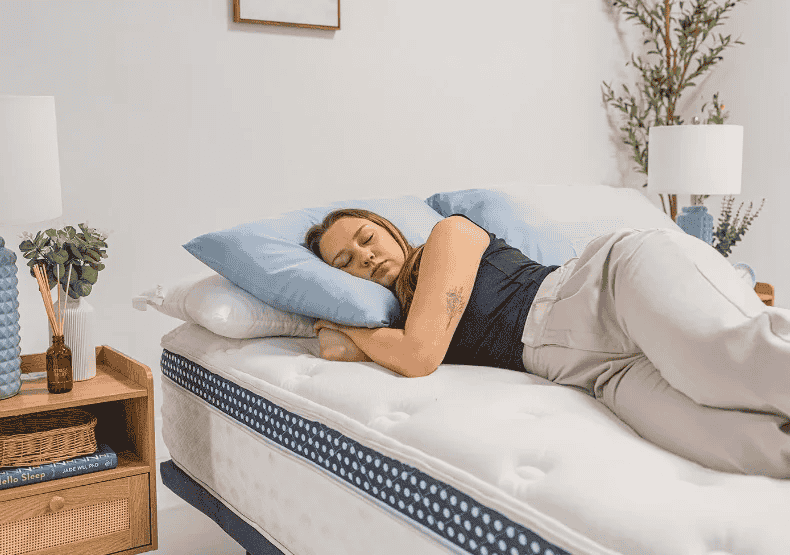Choosing the right mattress is essential for anyone, but if you sleep on your side, it becomes even more important to find a mattress recommended for side sleepers. Side sleepers face unique pressure points and alignment challenges that require specific mattress features to ensure a restful night’s sleep and avoid waking up with aches and pains. This guide will walk you through what to look for in a mattress if you sleep on your side, helping you make an informed decision for better comfort and support.
Why Side Sleepers Need a Different Mattress
Sleeping on your side is one of the most common sleep positions. It offers many health benefits, including reduced snoring and improved spinal alignment. However, it also places pressure on certain areas of the body — especially the shoulders, hips, and knees. If your mattress is too firm or too soft, these pressure points may become sore, leading to discomfort and restless nights.
The right mattress for side sleepers will provide a perfect balance of softness and support to cushion these pressure points while keeping your spine aligned. Without this balance, you might experience stiffness, numbness, or even chronic pain over time.
Key Features to Look for in a Mattress for Side Sleepers
1. Pressure Relief
Side sleepers need a mattress that excels in pressure relief. Since the body weight rests mostly on the hips and shoulders, a mattress that conforms to your curves and cushions these areas is crucial. Materials like memory foam and latex are excellent at distributing body weight evenly, reducing pressure buildup.
Look for a mattress with a thick, soft comfort layer made of memory foam or latex. These materials allow your hips and shoulders to sink in just enough, reducing strain and improving blood circulation during sleep.
2. Medium to Medium-Soft Firmness
Firmness is a critical factor when choosing a mattress for side sleeping. Too firm, and your pressure points won’t get enough cushioning; too soft, and your body might sink too deeply, throwing off spinal alignment.
Experts generally recommend a mattress with a medium to medium-soft firmness level for side sleepers — usually rated around 4 to 6 on a firmness scale of 1 to 10. This level offers enough softness to relieve pressure but enough support to maintain spinal alignment.
3. Spinal Alignment and Support
Maintaining a neutral spine alignment is key to preventing back and neck pain. When sleeping on your side, your mattress should support the natural curve of your spine from your neck down to your lower back.
A mattress that is too firm can cause your hips and shoulders to be elevated unnaturally, while one that’s too soft allows your body to sag. Look for a mattress with zoned support or a combination of materials designed to contour the body while supporting heavier areas like hips.
4. Responsiveness and Bounce
Some side sleepers prefer a mattress that offers a bit of bounce or responsiveness, especially if they tend to move around during the night or share the bed with a partner. Latex and hybrid mattresses (which combine coils with foam layers) are great options for this, as they provide responsive support without sacrificing pressure relief.
If you prefer memory foam, look for “gel-infused” or “open-cell” designs that offer better airflow and a slightly quicker response to movement.
5. Motion Isolation
If you share your bed, motion isolation can be an important feature. Side sleeping often involves curling up or changing positions more frequently. A mattress that isolates motion well ensures you won’t be disturbed by your partner’s movements, promoting better sleep quality for both.
Memory foam and hybrid mattresses typically perform best in motion isolation compared to traditional innerspring mattresses.
6. Temperature Regulation
Side sleepers can sometimes feel warmer due to the close contact their body has with the mattress. Look for mattresses with cooling technologies such as gel-infused foams, breathable covers, or hybrid designs with innerspring coils that allow for better airflow.
Materials like latex also tend to sleep cooler than traditional memory foam, making them a good choice if you tend to overheat.
7. Durability and Quality Materials
Investing in a high-quality mattress is important, especially since side sleepers rely heavily on the mattress to provide targeted support and cushioning. Look for mattresses with dense foams or quality latex layers that will retain their shape and performance over time.
Additionally, check reviews and warranty information to ensure long-term durability and customer satisfaction.
Types of Mattresses Recommended for Side Sleepers
Memory Foam Mattresses
Memory foam is highly popular among side sleepers because of its excellent contouring and pressure relief properties. It molds closely to the body’s curves, relieving pressure on hips and shoulders and supporting spinal alignment. Modern memory foam mattresses often include cooling gels or open-cell designs to combat heat retention.
Latex Mattresses
Latex mattresses offer a responsive and slightly bouncier feel compared to memory foam, while still providing good pressure relief. Natural latex is breathable and hypoallergenic, making it an excellent choice for sleepers who want a cooler sleep environment. The responsiveness of latex also helps with easy movement during the night.
Hybrid Mattresses
Hybrid mattresses combine innerspring coils with foam or latex comfort layers, offering a balanced feel of support, pressure relief, and bounce. The coils promote airflow and provide sturdy support, while the foam layers cushion pressure points. Hybrid mattresses are an excellent choice if you want the benefits of both foam and innerspring.
Pillow-Top Mattresses
Pillow-top mattresses feature an extra layer of cushioning sewn on top of the mattress surface. This plush layer can be beneficial for side sleepers who need additional softness for their hips and shoulders. Often available on innerspring or hybrid mattresses, pillow-tops can enhance pressure relief without sacrificing support.
Additional Tips for Side Sleepers Choosing a Mattress
- Test Before You Buy: If possible, lie down on a mattress in your side-sleeping position for at least 10–15 minutes to assess comfort and support.
- Consider Your Weight: Heavier side sleepers might require a slightly firmer mattress to avoid sinking too much, while lighter sleepers might prefer softer options.
- Use the Right Pillow: A supportive pillow that fills the space between your neck and shoulder will complement your mattress in maintaining proper spinal alignment.
- Look for Trial Periods and Warranties: Many mattress companies offer 100+ night trial periods, which are invaluable to ensure the mattress suits your side sleeping needs.
Conclusion
Choosing the right mattress as a side sleeper is crucial for comfort, spinal health, and overall sleep quality. Look for a mattress recommended for side sleepers that offers excellent pressure relief, medium to medium-soft firmness, proper spinal alignment, and temperature regulation. Memory foam, latex, and hybrid mattresses are all great options depending on your personal preferences and budget.
By understanding these factors, you’ll be better equipped to find a mattress that supports your body where it needs it most, helping you wake up refreshed and pain-free every morning.




Be First to Comment